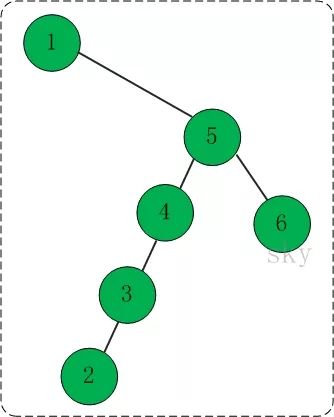二叉查找树之 Java的实现【下】
戳上面的 蓝字 关注我们哦!

本文作者:skywang12345
地址:cnblogs.com/skywang12345/p/3576452.html
完整的实现代码
二叉查找树的Java实现文件(BSTree.java)
/**
* Java 语言: 二叉查找树
*
* @author skywang
* @date 2013/11/07
*/
public class BSTree<T extends Comparable<T>> {
private BSTNode<T> mRoot; // 根结点
public class BSTNode<T extends Comparable<T>> {
T key; // 关键字(键值)
BSTNode<T> left; // 左孩子
BSTNode<T> right; // 右孩子
BSTNode<T> parent; // 父结点
public BSTNode(T key, BSTNode<T> parent, BSTNode<T> left, BSTNode<T> right) {
this.key = key;
this.parent = parent;
this.left = left;
this.right = right;
}
public T getKey() {
return key;
}
public String toString() {
return "key:"+key;
}
}
public BSTree() {
mRoot=null;
}
/*
* 前序遍历"二叉树"
*/
private void preOrder(BSTNode<T> tree) {
if(tree != null) {
System.out.print(tree.key+" ");
preOrder(tree.left);
preOrder(tree.right);
}
}
public void preOrder() {
preOrder(mRoot);
}
/*
* 中序遍历"二叉树"
*/
private void inOrder(BSTNode<T> tree) {
if(tree != null) {
inOrder(tree.left);
System.out.print(tree.key+" ");
inOrder(tree.right);
}
}
public void inOrder() {
inOrder(mRoot);
}
/*
* 后序遍历"二叉树"
*/
private void postOrder(BSTNode<T> tree) {
if(tree != null)
{
postOrder(tree.left);
postOrder(tree.right);
System.out.print(tree.key+" ");
}
}
public void postOrder() {
postOrder(mRoot);
}
/*
* (递归实现)查找"二叉树x"中键值为key的节点
*/
private BSTNode<T> search(BSTNode<T> x, T key) {
if (x==null)
return x;
int cmp = key.compareTo(x.key);
if (cmp < 0)
return search(x.left, key);
else if (cmp > 0)
return search(x.right, key);
else
return x;
}
public BSTNode<T> search(T key) {
return search(mRoot, key);
}
/*
* (非递归实现)查找"二叉树x"中键值为key的节点
*/
private BSTNode<T> iterativeSearch(BSTNode<T> x, T key) {
while (x!=null) {
int cmp = key.compareTo(x.key);
if (cmp < 0)
x = x.left;
else if (cmp > 0)
x = x.right;
else
return x;
}
return x;
}
public BSTNode<T> iterativeSearch(T key) {
return iterativeSearch(mRoot, key);
}
/*
* 查找最小结点:返回tree为根结点的二叉树的最小结点。
*/
private BSTNode<T> minimum(BSTNode<T> tree) {
if (tree == null)
return null;
while(tree.left != null)
tree = tree.left;
return tree;
}
public T minimum() {
BSTNode<T> p = minimum(mRoot);
if (p != null)
return p.key;
return null;
}
/*
* 查找最大结点:返回tree为根结点的二叉树的最大结点。
*/
private BSTNode<T> maximum(BSTNode<T> tree) {
if (tree == null)
return null;
while(tree.right != null)
tree = tree.right;
return tree;
}
public T maximum() {
BSTNode<T> p = maximum(mRoot);
if (p != null)
return p.key;
return null;
}
/*
* 找结点(x)的后继结点。即,查找"二叉树中数据值大于该结点"的"最小结点"。
*/
public BSTNode<T> successor(BSTNode<T> x) {
// 如果x存在右孩子,则"x的后继结点"为 "以其右孩子为根的子树的最小结点"。
if (x.right != null)
return minimum(x.right);
// 如果x没有右孩子。则x有以下两种可能:
// (01) x是"一个左孩子",则"x的后继结点"为 "它的父结点"。
// (02) x是"一个右孩子",则查找"x的最低的父结点,并且该父结点要具有左孩子",找到的这个"最低的父结点"就是"x的后继结点"。
BSTNode<T> y = x.parent;
while ((y!=null) && (x==y.right)) {
x = y;
y = y.parent;
}
return y;
}
/*
* 找结点(x)的前驱结点。即,查找"二叉树中数据值小于该结点"的"最大结点"。
*/
public BSTNode<T> predecessor(BSTNode<T> x) {
// 如果x存在左孩子,则"x的前驱结点"为 "以其左孩子为根的子树的最大结点"。
if (x.left != null)
return maximum(x.left);
// 如果x没有左孩子。则x有以下两种可能:
// (01) x是"一个右孩子",则"x的前驱结点"为 "它的父结点"。
// (01) x是"一个左孩子",则查找"x的最低的父结点,并且该父结点要具有右孩子",找到的这个"最低的父结点"就是"x的前驱结点"。
BSTNode<T> y = x.parent;
while ((y!=null) && (x==y.left)) {
x = y;
y = y.parent;
}
return y;
}
/*
* 将结点插入到二叉树中
*
* 参数说明:
* tree 二叉树的
* z 插入的结点
*/
private void insert(BSTree<T> bst, BSTNode<T> z) {
int cmp;
BSTNode<T> y = null;
BSTNode<T> x = bst.mRoot;
// 查找z的插入位置
while (x != null) {
y = x;
cmp = z.key.compareTo(x.key);
if (cmp < 0)
x = x.left;
else
x = x.right;
}
z.parent = y;
if (y==null)
bst.mRoot = z;
else {
cmp = z.key.compareTo(y.key);
if (cmp < 0)
y.left = z;
else
y.right = z;
}
}
/*
* 新建结点(key),并将其插入到二叉树中
*
* 参数说明:
* tree 二叉树的根结点
* key 插入结点的键值
*/
public void insert(T key) {
BSTNode<T> z=new BSTNode<T>(key,null,null,null);
// 如果新建结点失败,则返回。
if (z != null)
insert(this, z);
}
/*
* 删除结点(z),并返回被删除的结点
*
* 参数说明:
* bst 二叉树
* z 删除的结点
*/
private BSTNode<T> remove(BSTree<T> bst, BSTNode<T> z) {
BSTNode<T> x=null;
BSTNode<T> y=null;
if ((z.left == null) || (z.right == null) )
y = z;
else
y = successor(z);
if (y.left != null)
x = y.left;
else
x = y.right;
if (x != null)
x.parent = y.parent;
if (y.parent == null)
bst.mRoot = x;
else if (y == y.parent.left)
y.parent.left = x;
else
y.parent.right = x;
if (y != z)
z.key = y.key;
return y;
}
/*
* 删除结点(z),并返回被删除的结点
*
* 参数说明:
* tree 二叉树的根结点
* z 删除的结点
*/
public void remove(T key) {
BSTNode<T> z, node;
if ((z = search(mRoot, key)) != null)
if ( (node = remove(this, z)) != null)
node = null;
}
/*
* 销毁二叉树
*/
private void destroy(BSTNode<T> tree) {
if (tree==null)
return ;
if (tree.left != null)
destroy(tree.left);
if (tree.right != null)
destroy(tree.right);
tree=null;
}
public void clear() {
destroy(mRoot);
mRoot = null;
}
/*
* 打印"二叉查找树"
*
* key -- 节点的键值
* direction -- 0,表示该节点是根节点;
* -1,表示该节点是它的父结点的左孩子;
* 1,表示该节点是它的父结点的右孩子。
*/
private void print(BSTNode<T> tree, T key, int direction) {
if(tree != null) {
if(direction==0) // tree是根节点
System.out.printf("%2d is root/n", tree.key);
else // tree是分支节点
System.out.printf("%2d is %2d's %6s child/n",
tree.key, key, direction==1?"right" : "left");
print(tree.left, tree.key, -1);
print(tree.right,tree.key, 1);
}
}
public void print() {
if (mRoot != null)
print(mRoot, mRoot.key, 0);
}
}
二叉查找树的C++测试程序( BSTreeTest.java)
/**
* Java 语言: 二叉查找树
*
* @author skywang
* @date 2013/11/07
*/
public class BSTreeTest {
private static final int arr[] = {1,5,4,3,2,6};
public static void main(String[] args) {
int i, ilen;
BSTree<Integer> tree=new BSTree<Integer>();
System.out.print("== 依次添加: ");
ilen = arr.length;
for(i=0; i<ilen; i++) {
System.out.print(arr[i]+" ");
tree.insert(arr[i]);
}
System.out.print("/n== 前序遍历: ");
tree.preOrder();
System.out.print("/n== 中序遍历: ");
tree.inOrder();
System.out.print("/n== 后序遍历: ");
tree.postOrder();
System.out.println();
System.out.println("== 最小值: "+ tree.minimum());
System.out.println("== 最大值: "+ tree.maximum());
System.out.println("== 树的详细信息: ");
tree.print();
System.out.print("/n== 删除根节点: "+ arr[3]);
tree.remove(arr[3]);
System.out.print("/n== 中序遍历: ");
tree.inOrder();
System.out.println();
// 销毁二叉树
tree.clear();
}
}
在二叉查找树的Java实现中,使用了泛型,也就意味着支持任意类型; 但是该类型必须要实现Comparable接口。
二叉查找树的Java测试程序
上面的BSTreeTest.java是二叉查找树树的测试程序,运行结果如下:
== 依次添加: 1 5 4 3 2 6 == 前序遍历: 1 5 4 3 2 6 == 中序遍历: 1 2 3 4 5 6 == 后序遍历: 2 3 4 6 5 1 == 最小值: 1 == 最大值: 6 == 树的详细信息: is root is 1's right child is 5's left child is 4's left child is 3's left child is 5's right child == 删除根节点: 3 == 中序遍历: 1 2 4 5 6
下面对测试程序的流程进行分析!
(01) 新建"二叉查找树"root。
(02) 向二叉查找树中依次插入 1,5,4,3,2,6 。如下图所示:

(03) 遍历和查找
插入1,5,4,3,2,6之后,得到的二叉查找树如下:

前序遍历结果: 1 5 4 3 2 6
中序遍历结果: 1 2 3 4 5 6
后序遍历结果: 2 3 4 6 5 1
最小值是1,而最大值是6。
(04) 删除节点4。如下图所示:

(05) 重新遍历该二叉查找树。
中序遍历结果: 1 2 4 5 6
关注算法文摘,修炼开发内功

正文到此结束
热门推荐
相关文章
Loading...











![[HBLOG]公众号](http://www.liuhaihua.cn/img/qrcode_gzh.jpg)

